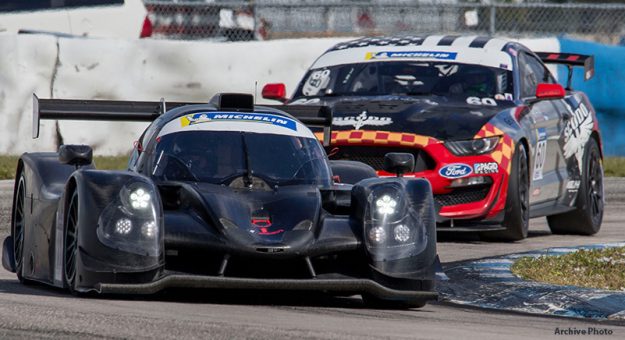With Prototype and GT Classes in a Sprint Format, the New IMSA Series Provides Great Development Prospects
By Mark Robinson
DAYTONA BEACH, Fla. – It is the newest IMSA development series that provides up-and-coming drivers the chance to hone their skills racing a prototype or a GT car on six of the finest circuits on the calendar. The VP Racing SportsCar Challenge takes off in just 12 weeks.
Announced during IMSA’s “State of the Sport” in August, the new series essentially succeeds the IMSA Prototype Challenge, the development series featuring Le Mans Prototype 3 (LMP3) cars, exclusively. The VP Racing SportsCar Challenge continues with LMP3 machinery but adds the GSX class for GT4 cars – such as those used in the IMSA Michelin Pilot Challenge Grand Sport (GS) class – to allow multi-class competition in two 45-minute sprint races each weekend.
“We seem to have a lot of energy building for the series and we’re pretty optimistic about it,” said Geoff Carter, IMSA’s senior director of Series Platforms overseeing the VP Racing SportsCar Challenge start-up along with IMSA Senior Series Coordinator Brian Wilson.
“We really like the LMP3 cars and we think they have a place in the IMSA ecosystem,” Carter added. “We wanted to create a lower barrier to entry and add a sprint format to hopefully reduce some costs, and to add the GT4 component to give the P3 drivers some multi-class experience in the event that they want to move up to the WeatherTech Championship.”
The LMP3 class continues for a third season in the IMSA WeatherTech SportsCar Championship in 2023. The GT4 cars are the same as those used in the IMSA Michelin Pilot Challenge and will adhere to the same Balance of Performance parameters.
The VP Racing SportsCar Challenge differs from the other series in that each entry is limited to one driver and there will be no pit stops in the 45-minute sprint events. Drivers must be rated Silver or Bronze by the latest FIA Driver Categorization to be eligible. This, Carter said, allows the opportunity for less experienced drivers to be more involved than in a two-driver format with a pro alongside.
“It gives the Bronze or the Silver the opportunity to set the car up for themselves and to develop more as an overall driver, as opposed to just getting in whatever the pro sets the car up for,” Carter explained. “It really does turn into a developmental challenge series and hopefully it’s a rung on the way up the ladder and not necessarily a destination.”
Carter added that he’s pleased with interest expressed in the series, with a goal of 12-15 entries per class.
“If we can achieve those car counts in the first season, we would be really pleased,” he said.
The race-weekend format includes a pair of 30-minute practices, a 15-minute qualifying session and the two 45-minute races. The schedule is as follows:
- Jan. 20-22: Daytona International Speedway (during the Roar Before the Rolex 24)
- March 11-12: Sebring International Raceway (during the WEC Prologue)
- July 7-9: Canadian Tire Motorsport Park
- July 21-22: Lime Rock Park
- Aug. 25-27: VIRginia International Raceway
- Oct. 11-14: Michelin Raceway Road Atlanta
